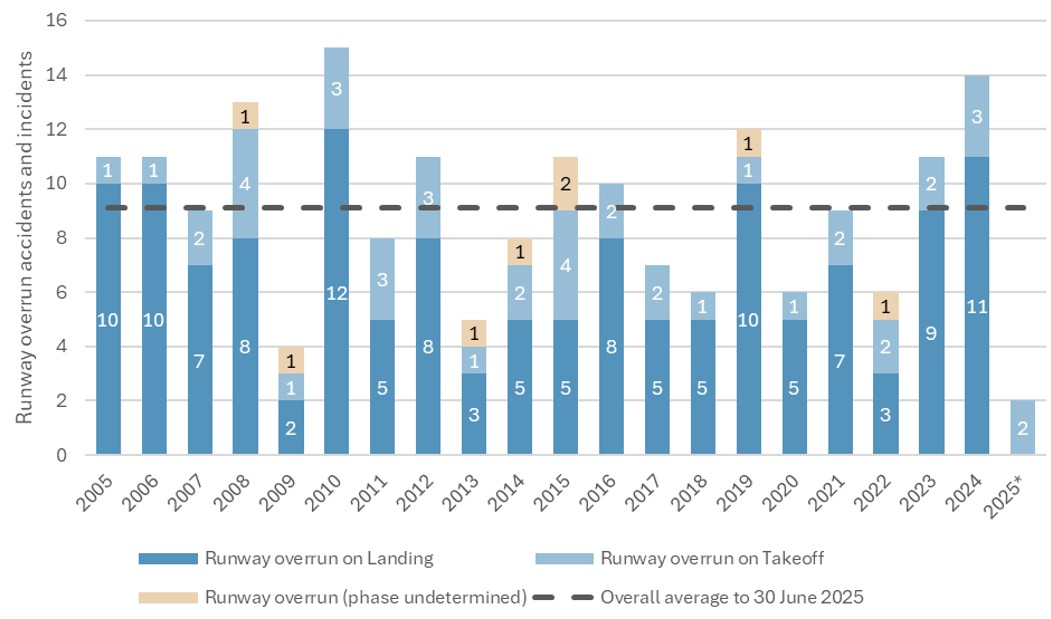Runway overruns
Runway overruns have been on the Watchlist since 2010, and continue to pose a risk to people, property, and the environment. While some airport operators and Transport Canada (TC) have taken action, runway overruns continue to occur.
The situation
Each year, millions of flights are completed safely in Canada, yet runway overruns during landings or rejected takeoffs still occur. These overruns can cause damage to airplanes and the environment, injuries, and even loss of life—especially when there are not adequate runway-end safety areas (RESAs) or arresting systems in place.
Number of occurrences
From January 1, 2005 to June 30, 2025, there were, on average, nine runway overrun occurrences per year at Canadian aerodromes (Figure 1), seven of which occurred during landing. While numbers vary annually, there is no statistically significant trend. The Transportation Safety Board of Canada (TSB) investigated 32 of 189 occurrences in this period, issuing six recommendations to Canadian authorities. Five recommendations are still activeTSB recommendations A20-02, A20-01, A07-06, A07-05, and A07-01. and one is closed.TSB Recommendation A07-03. Since April 1, 2022, the TSB has received 30 reports of runway overruns, of which eight resulted in investigations with findings or safety messages.
Action taken
Watchlist issues are complex and require coordinated action from operators, regulators and other stakeholders. While some progress has been made, much more is needed. The following steps have been taken to date.
Regulatory activities
In January 2022, TC published regulations in response to TSB Recommendation A07-06, requiring:
- airports with over 325 000 commercial passengers annually to have a 150 m RESA on runways.
- an arresting system in place on runways where a 150 m RESA cannot be implemented.
However these regulations fall short of ICAO standards, which call for a 150 m RESA for all runways 1200 m or longer, and recommend a 300 m RESA.
- TC estimates that the regulations will increase passenger protection from 75% (2017) to 95% (2038). Still, the regulations do not cover smaller airports, non-passenger traffic, and terrain hazards beyond runway ends. However, some airports are voluntarily meeting ICAO’s standards and recommendations.
- Of the 16 runway overruns investigated by the TSB between 2013 and 2024, 10 occurred at airports with fewer than 325,000 passengers.
Where geographic constraints limit the design and construction of adequate RESAs, engineered materials arresting systems (EMAS) can mitigate the risk. In March 2025, there were 122 EMAS installed at 70 airports in the U.S.Federal Aviation Administration, “Two EMAS Systems Successfully Stop Aircraft in Separate Incidents” at https://www.faa.gov/newsroom/two-emas-systems-successfully-stop-aircraft-separate-incidents (last accessed on 17 September 2025). To date, none have been installed in Canada.
Prevention initiatives
Since runway overruns first appeared on the Watchlist, several initiatives have aimed to reduce risk. In response to several investigations, the TSB has made the following recommendations:
- RESA requirements (A07-06)
- Risks in approaches into convective weather (A07-01)
- Landing distance considerations (A07-05)
- Landing minima in Canada (A20-01 and A20-02)
In 2021, TC introduced the requirement to use the Global Reporting Format (GRF),TC’s global reporting format allows the reporting of two surface contaminants rather than the one contaminant allowed by ICAO (Source: Transport Canada, Advisory Circular (AC) No. 700-057, at https://tc.canada.ca/en/aviation/reference-centre/advisory-circulars/advisory-circular-ac-no-700-057 [last accessed 08 October 2025]). This difference will make Canada’s reporting more consistent with the U.S. Federal Aviation Administration’s Takeoff and Landing Performance Assessment, which also allows two contaminants to be reported. ICAO’s globally harmonized means of runway surface condition assessment and reporting. The GRF provides flight crews with improved information about expected braking action when they determine landing performance.
Globally, the aviation industry is addressing runway overruns with in-cockpit technological solutions. Runway Overrun Awareness and Alerting Systems (ROAAS)Prior to touchdown, ROAASs monitor numerous in-flight parameters and send alerts to pilots if a landing cannot be completed in a runway’s available landing distance. Post-touchdown, ROAASs monitor braking performance and send alerts to pilots if an airplane cannot be stopped within the remaining distance on the runway., are already used in many Airbus and Boeing fleets and can be integrated into other airplane types. The European Union Aviation Safety Agency is also moving to requireEuropean Union Aviation Safety Agency, Certification Specifications and Acceptable Means of Compliance for Large Aeroplanes (CS-25), Amendment 27 (24 November 2021), at https://www.easa.europa.eu/downloads/136622/en (last accessed on 03 October 2025). ROAAS on newly designed Part 25 large airplanes operated in commercial air transportation; however, currently, there is no regulatory requirement for these types of awareness and alerting systems in Canada.
Canadian aviation operators are acknowledging the issue. A TSB survey of industry stakeholders found that the majority of responding participants had safety management processes that identified the issue of runway overruns and that had taken or were taking action to address the issue. Proactive measures include applying stable approach criteria to ensure aircraft are correctly configured and safely descending before touchdown, and strengthening pilot training to enhance readiness for challenging runway conditions and critical in-flight decision-making.
Action required
Runway overruns in Canada have been an issue of concern for the TSB for more than two decades, highlighting the need for a coordinated, sustained safety strategy. While total elimination may be unrealistic, significant improvements, especially regarding regulatory gaps, poor infrastructure and outdated technology, are essential.
Accurate and real-time surface data, especially in poor weather, is essential for safe landings and preventing runway overruns. This issue will remain on the TSB Watchlist until:
- TC implements and enforces weather-related landing restrictions, including approach bans.
- Runway overruns alerting technologies are widely adopted by CAR 705 operators.
- Runway condition reporting and infrastructure are upgraded at aerodromes deficient in these areas.
- Wider adoption by airport operators of ICAO standards for RESA.

